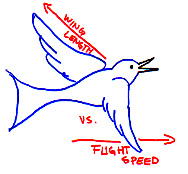What are scaling relationships?
How do organisms change as body size increases or decreases? This is the fundamental question behind studies that measure scaling. Most scaling studies have focused on how physical structures (such as body shape) or physiological factors (such as metabolism or heart rate) changes with size. There are lots of types of factors that could be examined in relation to size. Here are a few:

|

|

|
Why study these relationships? Well, if you understand how form or functions change as organisms get bigger or smaller, it is possible to learn something fundamental about what underlies the processes or learn about what factors place evolutionary limits on organismal growth and adaptations. For instance, determining at what size arthropods can no longer support the weight of their exoskeleton gives us clues about the limits of their growth.
Scaling studies have a long history in biology, but the physiological relationship that has received the most attention is how metabolic rate changes as organisms get larger. Therefore, we are going to focus on that example as we go through some of the mathematical concepts that underlie the science of scaling. So, what do we really mean by scaling? Let's use a concrete example so you'll know what we mean.
Here is some data on body size and metabolic rate for mammals. Later, we're going to show you an expanded data set of over 600 mammals so we can examine this relationship more rigorously, but for right now, we'll start with just four:

OK, a couple of things that we want you to notice. The first is that metabolic rate increases as animals get bigger.
That's because we are specifically interested in total energy consumed (here measured through oxygen consumption). Of
course, bigger animals will use more oxygen than smaller ones (think about how big a breath a lion takes compared to a
mouse). But look at the values adjusted for body size (the last value listed for each species). Mice use a lot more oxygen
per gram than a lion. This means that lions use oxygen more efficiently than mice. There is something else to notice. As
mammals get bigger, this increase in efficiency is not linear (notice how the steepness of the slope
decreases as size increases). This means that metabolism does not scale linearly with body size.
Right now, you may be thinking to yourself: "Who cares?" Well, it turns out that how metabolism (and other factors) scales with body size can give important information about which factors are most important in limiting these biological functions. If we can understand that, we understand a lot more about biology! All right, now that you're convinced of the importance of these studies - let's look at these relationships in more depth by seeing how people model them mathematically!
Copyright University of Maryland, 2007
You may link to this site for educational purposes.
Please do not copy without permission
requests/questions/feedback email: mathbench@umd.edu